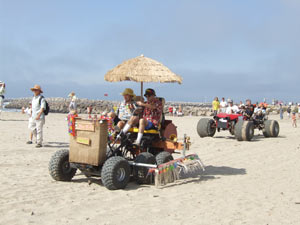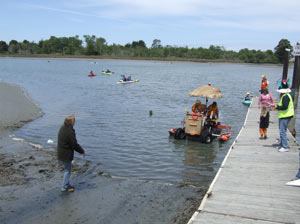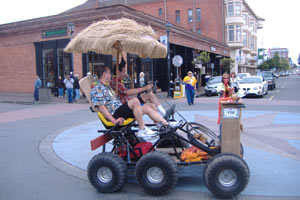
Handy Links
SLAC News Center
SLAC Today
- Subscribe
- Archives: Feb 2006-May 20, 2011
- Archives: May 23, 2011 and later
- Submit Feedback or Story Ideas
- About SLAC Today
SLAC News
Lab News
- Interactions
- Lightsources.org
- ILC NewsLine
- Int'l Science Grid This Week
- Fermilab Today
- Berkeley Lab News
- @brookhaven TODAY
- DOE Pulse
- CERN Courier
- DESY inForm
- US / LHC
SLAC Links
- Emergency
- Safety
- Policy Repository
- Site Entry Form

- Site Maps
- M & O Review
- Computing Status & Calendar
- SLAC Colloquium
- SLACspeak
- SLACspace
- SLAC Logo
- Café Menu
- Flea Market
- Web E-mail
- Marguerite Shuttle
- Discount Commuter Passes
-
Award Reporting Form
- SPIRES
- SciDoc
- Activity Groups
- Library
Stanford
Around the Bay
All-terrain Tiki Bar Takes Ventura
Crossing pavement, sand, water and a giant mud bog, Quality Control Manager Mike Saleski and his improbable human-powered vehicle took top honors last month in the 11th annual Kinetic Sculpture Race at Ventura, California. This was the third race and the first win for the Tiki Bar and its pilot Saleski, who manages a team responsible for personnel protection and beam containment systems on the SLAC National Accelerator Laboratory linac.
Saleski welded together the Tiki Bar from scratch. "There are about eight bicycles and a go-cart in that vehicle," he said. Bike hubs and 147 gears are joined with go-cart axels, disc brakes and steering in the pedal-driven, two-person vehicle. The Tiki Bar's artistic design is based on the Polynesian-themed cocktail bars, such as the canonical Trader Vic's. Originally, Saleski had planned a mobile queen-sized canopy bed. But then he took his undecorated vehicle to the Burning Man festival north of Reno, Navada, where he used a large umbrella as shielding against the desert sun. His wife suggested using the thatch-covered umbrella for the race. Saleski added a grass-hut-style wet bar to the front, and the All-terrain Tiki Bar was born.
The Ventura race covers about a mile on Ventura Bay, 3/4 miles on a sandy beach, several laps around a figure-eight track, then about 150 feet slogging through mud. One- to four-person vehicles compete for points in three areas—art, engineering and speed—necessitating trade-offs between form and function. Fast designs are generally lighter, with less material for artful adornments. Saleski took advantage of the lightweight thatching to give his entry a whimsical air. Engineering a vehicle that the team can power across pavement, sand and water is challenging, and contestants vary in their choices of art versus ambulation. In another 2008 race, one entry decorated as a shiny dragon looked great until its heavy head and neck caused it to capsize just meters from the launching dock. The third race metric, speed, is the most straightforward to measure, but tough to achieve while meeting the full race criteria.
To be eligible for top prizes, contestants must adhere to a set of rules governing race conduct, called Ace. To achieve Ace status, the vehicles must first meet safety requirements. Next, the "pilots," as the contestants are called, must power their vehicles while on-board; they can't get out and push. On top of that, every mobile sculpture must carry all of its equipment throughout the race. For Saleski, that meant lugging two heavy outrigger pontoons across the sand and pavement.
Saleski and his race partner maintained their Ace status at Ventura while taking first place for speed, to win the Grand Championship with their overall score.
This was the Tiki Bar's third and best race so far, and the product of several design modifications. At its first race, one year ago at Ventura, the Tiki Bar ran into buoyancy problems. The vehicle sunk too deep in the water; its two, 22-inch paddlewheels were submerged past the axel, and powered the craft backward almost as much as forward. "We were struggling to get in the race at all," Saleski said. Additional floatation, including a broad Styrofoam platform, and larger paddlewheels did the trick. The Tiki Bar's second race, this time the Arcata-Ferndale Kinetic Sculpture Race near Eureka, California, was an improvement. But significantly longer distances combined with the high rolling resistance of large all-terrain tires kept victory out of reach. For the third race, once again a short sprint in Ventura, Saleski and the Tiki Bar were ready to win. "I was thinking of retiring it," Saleski said, "but now it's Ventura Champion so it would be a sin to retire it."
That said, Saleski noted that the next race, his second at Arcata-Ferndale, is a long one again, covering five towns and 45 miles. "It's like a marathon," he said. "You're in it for the long haul." At around 500 pounds, the Tiki Bar is not a long-distance contender. "I'm already starting to build another vehicle," Saleski said. With lower-rolling-resistance wagon wheels, this one should be faster on pavement. That leaves sand and water; no doubt Saleski has something creative in mind.
—Shawne Workman
SLAC Today, November 25, 2008
See the Tiki Bar in action on YouTube: climbing out of Eureka Harbor and bombing down "Dead Man's Drop" in the sand dunes near Samoa, California (Arcata-Ferndale race).


